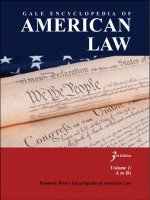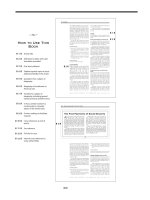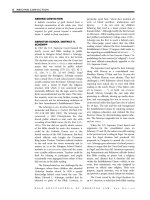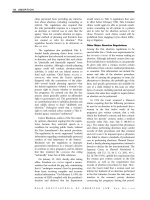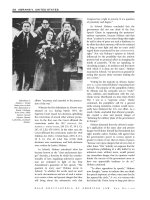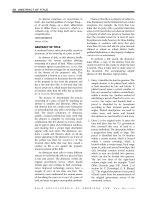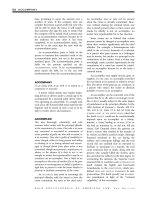Gale Encyclopedia Of American Law 3Rd Edition Volume 1 P7 docx
Bạn đang xem bản rút gọn của tài liệu. Xem và tải ngay bản đầy đủ của tài liệu tại đây (245.21 KB, 10 trang )
S. Ct. 568, 50 L. Ed. 2d 471 [1977]). This
precedent seemed to give school authorities
ample means to elude
LIABILITY for unconstitu-
tional terminations. However, neither of the
principles helped City University of New York
(CUNY) when it was sued by the chair of its
black studies department.
Professor Leonard Jeffries specialized in black
studies and the history of Africa, and his teaching
style at CUNY was controversial. Some students
felt that Jeffries discouraged classroom debate,
whereas others applauded him for verbalizing the
frustrations of many African Americans. Jeffries
referred to Europeans as “ice people” and
as “egotistic, individualistic, and exploitative.”
Africans, by contrast, were “sun people” who had
“humanistic, spiritualistic value system[s].”
On July 20, 1991, Jeffries spoke at the
Empire State Black Arts and Cultural Festival, in
Albany, New York. In his speech, he assailed
perceived Jewish power, asserting that Jews
controlled CUNY and Hollywood and had
financed the American slave trade. The speech
attracted national attention and placed CUNY
on the horns of a dilemma: Either it could
punish Jeffries and risk running afoul of the
First Amendment and academic freedom prin-
ciples, or it could do nothing and risk losing
expected income from offended school bene-
factors. For several months, the univers ity
wrestled with the problem. Then, in October,
the board of trustees voted, without explana-
tion, to limit Je ffries’s current appointment as
chair to one year instead of the customary three.
On March 23, 1992, the CUNY Board of
Trustees appointed Professor Edmund Gordon
to the positio n of black studies chair. Jeffries
filed suit in federal court on June 5, 1992.
Jeffries argued that the defendants violated
his First Amendment free speech rights and his
FOURTEENTH AMENDMENT due process rights when
they denied him a full three-year term as chair
of black studies. The jury agreed with Jeffries
that a substantial motivating factor in his
dismissal was his speech in Albany. The jury
did find, however, that CUNY had reasonably
expected the speech to have a detrimental effect
on the school. Despite this seemingly justifiable
excuse for the school’s action, the jury finally
found that CUNY had deprived Jeffries of
property (the position of chair) without
DUE
PROCESS OF LAW
. The district court judge held that
Jeffries’s First Amendment rights had been
violated, and in August 1993 reduced Jeffries’s
recovery in damages by $40,000 but awarded
him the black studies chair ( Jeffries v. Harleston,
828 F. Supp. 1066 [S.D.N.Y., 1993]).
Upon
APPEAL, the U.S. Supreme Cour t
remanded the case to the Second Circuit with
instructions to consider the Court’s
RULING in
Waters v. Churchill (511 U. S. 661 [1994]). The
CIRCUIT COURT reversed and remanded the case
to the district court. The
FINAL DECISION con-
cluded that Jeffries’s occupation did not afford
him “greater protection from state interference
with his speech than did the nurse in Waters.”
By taking away Jeffries’s position as chair of the
department, the university did not infringe on
his ability to speak publicly or to teach in his
own style, both of which could have been
violations of his First Amendment rights (Jeffries
v. Harleston, 52 F. 3d 9 [2d Cir. 1995]).
The Supreme Court has decided several
cases that identified more precisely how much
control school authorities may exercise over
education. The Court held in Board of Ed.,
Island Trees Union Free School Dist. No. 26 v.
Pico (457 U.S. 853, 102 S. Ct. 2799, 73 L. Ed. 2d
435 [1982]), that a school board can control
curriculum and book selection, but it may not
remove “objectionable” books from public
school libraries solely in response to community
pressure. Among the books that the Island Trees
Union Free School District No. 26 in New York
had banned in the mid-1970s were Slaughter-
house Five, by Kurt Vonnegut Jr.; Black Boy,
by Richard Wright; Naked Ape, by Desmond
Morris; and The Fixer, by Bernard Malamud.
School boards and state legislatures generally
control public school curriculums, but their
control is not complete. For instance, a state
statute will be struck down if it requires public
schools to also teach creationism if they teach
evolution and vice versa. According to the Court
in Edwards v. Aguillard (482 U.S. 578, 107 S. Ct.
2573, 96 L. Ed. 2d 510 [1987]), such a law un-
dermines a comprehensive scientific education
and impermissibly endorses
RELIGION by advanc-
ing the religious belief that a supernatural power
created human beings.
State legislatures have accommodated court
rulings by drafting legislative language intended
to create academic latitude without violating
CONSTITUTIONAL rights. In July 2008 Louisiana
governor Bobby Jindal signed into law the
Louisiana Science Edu cation Act, S.B. 733,
GALE ENCYCLOPEDIA OF AMERICAN LAW, 3RD E DITION
48 ACADEMIC FREEDOM
which (according to the act’s preamble) pur-
ported to “promote students’ critical thinking
skills and open discussion of scientific theories”
in Louisiana classrooms. Section §285(B)(1) of
the act states:
The State Board of Elementary and Second-
ary Education, upon request of a city, parish,
or other local public school board, shall
allow and assist teachers, principals, and
other school administrators to create and
foster an environment within public elemen-
tary and secondary schools that promotes
critical thinking skills, logical analysis, and
open and objective discussion of scientific
theories being studied including, but not
limited to, evolution, the origins of life,
global warming, and human cloning.
Section §285(C) provides that after teaching
the material contained in a standard textbook
supplied by the school system, a teacher may
use supplemental textbooks and other instruc-
tional mat erials “to help students understand,
analyze, critique, and review scientific theories
in an objective manner.”
Section §285(D) expressly states: “This Sec-
tion shall not be construed to promote any
religious doctrine, promote
DISCRIMINATION for
or against a particular set of religious beliefs, or
promote discrimination for or against religion
or non-re ligion.”
The Louisiana Science Education Act was
one of several similar bills introduced in state
legislatures in 2008 and 2009, including those in
Alabama (HB 300), Florida, Iowa (HF 183),
Michigan, Missouri (HB 656), New Mexico (SB
433), Oklahoma (SB 320), South Carolina, and
Texas (HB 224). Only Louisiana’s was enacted
in 2008. (Oklahoma’s bill, the language of
which closely paralleled that of Louisiana, was
narrowly defeated by a 7-6 vote in the state’s
Senate Edu cation Committee in early 2009.)
The question regarding whether the federal
government can deny grants or funds to
educational institutions which speak out against
federal policies was the issue before the courts
in Rumsfeld v. F.A.I.R. (Forum for Academic and
Institutional Rights, Inc.) (547 U.S. 47, 126 S. Ct.
1297 [2006]). Congress had passed the
SOLOMON
AMENDMENT
in 1994 (10 U.S.C. 983), which
requires the U.S.
DEPARTMENT OF DEFENSE (DOD)
to deny federal funding to institutions of higher
education that prohibit
ACCESS to the institution
for military representatives and/or deny or
impede assistance for recruiting purposes.
The conflict arose over military policies
regarding homosexua lity. Since at least
WORLD
WAR I
, the U.S. military maintained a policy of
excluding service members based on evidence of
homosexual conduct or orientation (10 U.S.C.
654). Unlike the military, many graduate
schools (and law schools in particular) have,
over the years, maintained formal policies
expressly tolerant of expanded personal factors
such as sexual orientation. Of particular import
in this case was the prevalence of law school
policies that withheld career services/career
placement services from prospective employers
who discriminated on the grounds of sexual
orientation as well as the more traditional
protected categories such as race, gender, religion.
In F.A.I.R. v. Rumsfeld, No. 03-4433 (3d
Circuit Court of Appeals, 2004) the two
conflicting policies over homosexuality faced-
off in court, when a coalition of law schools
and law faculty calling itself the Forum for
Academic and Institutional Rights (F.A.I.R.)
filed
PETITION for PRELIMINARY INJUNCTION in the
U.S. District Court for the District of New Jersey
to enjoin enforcement of the Solomon Amend-
ment. The Third Circuit Court of Appeals
granted injunction against enforcement of
the Solomon Amendment, holding that the
law violated schools’ First Amendment rights
of expressive association, and forcing them to
engage in the expressive act of recruiting. It
reasoned that Congress could not require the
FORFEITURE of a constitutional right as the basis
for receiving federal funds. But the U.S. Supreme
Court unanimously reversed, holding that the
government could deny funds to schools that
did not permit recruitment; indeed, said
the Court, through the U.S. Constitution’s “raise
and support Armies” clause (Article I, Section
8), Congress could go so far as to force schools
to allow recruiting without even threatening
the withholding of funds. The Court continued
that the Solomon Amendment neither denied
the institutions the right to speak nor required
them to say anything.
Though the concept of acad emic freedom
has traditionally been applied only to teachers, it
has affected lower-court opinions involving the
rights of students. Several Supreme Court cases
are cited in support of such rights. In Healy v.
James (408 U.S. 169, 92 S. Ct. 2338, 33 L. Ed. 2d
266 [1972]), the Supreme Court held that a
public university may deny campus access to
GALE ENCYCLOPEDIA OF AMERICAN LAW, 3RD E DITION
ACADEMIC FREEDOM 49
provably disruptive groups, but it may not deny
access based on the views the students wish to
express. The Supreme Court ruled in Hazelwood
School District v. Kuhlmeier (484 U.S. 260, 108
S. Ct. 562, 98 L. Ed. 2d 592 [1988]) that a public
school may censor the content of a student
newspaper if the newspaper is not an entirely
public forum and the reason for
CENSURE is
related to a legitimate educational concern. In
Board of Education of Westside Community
Schools (Dist. 66) v. Mergens (496 U.S. 226,
110 S. Ct. 2356, 110 L. Ed. 2d 191 [1990]), the
Court approved the establishment of a Christian
student group in a public school. The Court
also held in Mergens that a school’s refusal to
permit a religious student group to meet at
school and use its facilities violates the federal
Equal Access Act (Education for Economic
Security Act § 802, 20 U.S.C.A. § 4071 et seq.
[1984]) if the school provides such access to
other extracurricular student groups. And in
Morse v. Frederick (551 U.S. 393 [2007]), the
Supreme Court held that a student’s free speech
rights were not violated when he was suspended
for displaying a “Bong Hits 4 Jesus” banner
during a school authorized event. The Court
distinguished the constitutional rights of stu-
dents in public schools from adults in other
settings, finding that students’ rights could be
delineated “in light of the special characteristics
of the school environment.”
FURTHER READINGS
“Act No. 473 (Senate Bill No. 733).” Text available online at
/>did=503483; website home page: te.
la.us (accessed July 10, 2009).
DeGeorge, Richard T. 1997. Academic Freedom and
Tenure: Ethical Issues. Lanham, Md.: Rowman &
Littlefield.
Finkin, Matthew W., and Robert C. Post. 2009. For the
Common Good: Principles of American Academic
Freedom. New Haven, Conn.: Yale Univ. Press.
Hamilton, Neil W. 2002. Academic Ethics: Problems and
Materials on Professional Conduct and Shared Gover-
nance. Westport, Conn.: Praeger.
Hiers, Richard H. 2002. “Institutional Academic Freedom
vs. Faculty Academic Freedom in Public Colleges and
Universities: A Dubious Dichotomy.” Journal of College
and Univ. Law 29 (October): 35-109.
Rahdert, Mark C. July 2007. “The Roberts Court and
Academic Freedom.” Chronicle of Higher Education 53.
CROSS REFERENCES
Censorship; Douglas, William Orville; First Amendment;
Frankfurter, Felix; Freedom of Speech; Loyalty Oath;
Religion; Schools and School Districts; Tenure; Warren, Earl
ACADEMIC YEAR
That period of time necessary to complete an
actual course of study during a school year.
SOCIAL SECURITY benefits may terminate at the
end of an
ACADEMIC YEAR, or a deferment from
compulsory military service may continue only
during an academic year.
ACADEMY OF CRIMINAL JUSTICE
SCIENCES
The Academy of Criminal Justice Sciences (ACJS)
was founded in 1963 to foster professionalism in
the criminal justice system by advancing the
quality of education and research programs in the
field. The academy seeks to enrich education and
research programs in institutions of higher
learning, criminal justice agencies, and agencies
in related fields by improving cooperation and
communication, by serving as a clearinghouse for
the collection and dissemination of information
produced by the programs, and by promoting the
highest ethical and personal standards in criminal
justice research and education. To that end, the
ACJS created an ad hoc committee in 1995 to
adopt minimum standards for the improvement
of quality in criminal justice higher education.
The standards, reprinted in 2001, have been
widely utilized in the curricular development of
associate, undergraduate and graduate degree
programs. The academy also
PRESENTS numerous
awards for outstanding contributions by indivi-
duals in the field. The members of the academy
are individual teachers, administrators, research-
ers, students, and practitioners.
The academy publishes the Journal of Crimi-
nal Justice quarterly and a directory annually. It
holds annual meetings in March.
FURTHER READINGS
Academy of Criminal Justice Sciences Web site. Available
online at (accessed July 2, 2009).
“J Journal: New Writing on Justice” New York: John Jay
College of Criminal Justice. Available online at http://
www.conference2004.jjay.cuny.edu/jjournal/index.asp;
website home page: y.
cuny.edu/ (accessed August 28, 2009).
ACCEDE
To consent or to agree, as to accede to another’s
point of view. To enter an office or to accept a
position, as to accede to the presidency.
ACCELERATION
A hastening; a shortening of the time until some
event takes place.
GALE ENCYCLOPEDIA OF AMERICAN LAW, 3RD E DITION
50 ACADEMIC YEAR
A person who has the right to take
possession of property at some future time
may have that right accelerated if the present
holder loses his or her
LEGAL RIGHT to the
property. If a
LIFE ESTATE fails for any reason, the
remainder is accelerated.
The principle of acceleration can be applied
when it becomes clear that one party to a
contract is not going to perform his or her
obligations.
ANTICIPATORY REPUDIATION, or the
possibility of future breach, makes it possible
to move the right to remedies back to the time
of repudiation rather than to wait for the time
when performance would be due and an actual
breach would occur.
ACCELERATION CLAUSE
The provision in a credit agreement, such as a
mortgage, note, bond, or deed of trust, that allows
the lender to require immediate payment of all
money due if certain conditions occur before the
time that payment would otherwise be due.
The agreement may call for
ACCELERATION
whenever there i s a default of an y important
obligation, such as nonpayment of principal or
interest, or the failure to pay insurance premiums.
ACCEPTANCE
An express act or implication by conduct that
manifests assent to the terms of an offer in a manner
invited or required by the offer so that a binding
contract is formed. The exercise of power conferred
by an offer by performance of some act. The act of a
person to whom something is offered or tendered by
another, whereby the offeree demonstrates through
an act invited by the offer an intention of retaining
the subject of the offer.
In the law of contracts, acceptance is one
person’s compliance with the terms of an offer
made by another. Acceptance occurs in the law
of insurance when an insurer agrees to receive a
person’s application for insurance and to issue a
policy protecting the person against certain
risks, such as fire or
THEFT. When a person who
is offered a gift by someone keeps the gift, this
indicates his or her acceptance of it.
Acceptance also occurs when a bank pays a
check written by a customer who has a checking
account with that bank.
In business dealings between merchants,
which is governed by the law of sales, a buyer
demonstrates his or her acceptance of goods that
are not exactly what he or she had ordered from
the seller by telling the seller that he or she will
keep the goods even though they are not what was
ordered; by failing to reject the goods; or by doing
something to the goods inconsistent with the
seller’s ownership of them, such as selling the
goods to consumers of the buyer’sstore.
Types of Acceptance
An acceptance may be conditional, express, or
implied.
Conditional Acceptance A conditional accep-
tance, sometimes called a
QUALIFIED ACCEPTANCE,
occurs when a person to whom an offer has
been made tells the offeror that he or she is
willing to agree to the offer provided that some
changes are made in its terms or that some
condition or event occurs. This type of accep-
tance operates as a
COUNTEROFFER. A counteroffer
must be accepted by the original offeror before a
contract can be established between the parties.
Another type of conditional acceptance
occurs when a drawee promises to pay a draft
upon the fulfillment of a condition, such as a
shipment of goods reaching its destination on
the date specified in the contract.
Express Acceptance An express acceptance
occurs when a person clearly and explicitly
agrees to an offer or agrees to pay a draft that is
presented for payment.
Implied Acceptance An implied acceptance is
one that is not directly stated but is demon-
strated by any acts indicating a person’s assent
to the proposed bargain. An implied acceptance
occurs when a shopper selects an item in a
supermarket and pays the cashier for it. The
shopper’s conduct indicates that he or she has
agreed to the supermarket owner’s offer to sell
the item for the price stated on it.
FURTHER READINGS
Chirelstein, Marvin A. 2006. Concepts and Case Analysis in
the Law of Contracts. 5th ed. Eagan, MN: West.
Perillo, Joseph M. 2009. Calamari and Perillo’s Hornbook on
Contracts. 6th ed. Eagan, MN: West.
“Silence as Acceptance in Contracts Lawyers.” 2009.
LegalMatch Website. Available online at http://www.
legalmatch.com/law-library/article/silence-as-acceptance-
in-contracts.html; website home page: http://www.
legalmatch.com (accessed August 28, 2009).
ACCESS
Freedom of approach or communication; or the
means, power, or opportunity of approaching,
GALE ENCYCLOPEDIA OF AMERICAN LAW, 3RD E DITION
ACCESS 51
communicating, or passing to and from. Sometimes
importing the occurrence of sexual intercourse;
otherwise as importing opportunity of communica-
tion for that purpose as between
HUSBAND AND WIFE.
In real property law, the term access denotes
the right vested in the owner of the land that
adjoins a road or other highway to go and return
from his own land to the highway without
A sample acceleration
clause
ILLUSTRATION BY GGS
CREATIVE RESOURCES.
REPRODUCED BY
PERMISSION OF GALE,
A PART OF CENGAGE
LEARNING.
FOR VALUE RECEIVED, WE, THE UNDERSIGNED, jointly and severally promise to pay, in lawful money of the United States of America,
to the order of __________________________________________ at ____________________________________________________,
(__________) Dollars in installments as follows:
_____________________________ on ___________________________________ , and _________________ successive payments
of ____________________________ beginning on _________________________________ together with a delinquency charge on
each installment in default for _________________ days in an amount equal to _______________ percent of such installment but not
less than $_______________________ .
In the event of default in the payment of any of the said installments or said interest when due as herein provided, time being of the
essence hereof, the holder of this note may, without notice or demand, declare the entire principal sum then unpaid immediately due and
payable.
The holder of this note may, with or without notice to any of us, cause additional parties to be added hereto, or release any party hereto,
or revise, extend, or renew the note, or extend the time for making any installment provided for herein, or accept any installment in
advance, all without affecting the liability of us, or any of us, hereon.
If suit be commenced on said note, the parties hereto jointly and severally agree to pay to the holder of said note a reasonable attorney
fee.
The borrower agrees to pay a reasonable collection charge should collection be referred to a collection agency or to the payee`s
collection facilities.
The parties hereto, jointly and severally, hereby waive presentment, demand, protest, notice of dishonor and/or protest and notice of
nonpayment; the right, if any, to the benefit of, or to direct the application of, any security hypothecated to the holder until all indebtedness
of the borrower to the holder shall have been paid; the right to require the holder to proceed against the borrower, or to pursue any other
remedy in the holder's power; and agree that the holder may proceed against us directly and independently of the borrower, and that the
cessation of liability of the borrower for any reason, other than full payment, or any revision, renewal, extension, forebearance, change of
rate of interest, or acceptance, release or substitution of security, or any impairment or suspension of the holder's remedies or rights
against the borrower, shall not in anywise affect the liability of any of the parties hereto.
The parties hereto hereby authorize __________________________________________ to date this note as of the day when the loan
evidenced hereby is made and to complete this note in any other particular according to the terms of the said loan.
It is agreed that if the parties hereto, or any of them at any time fail in business or become insolvent, or commit an act of bankruptcy, or
if any deposit account or other property of the parties hereto, or any of them, be attempted to be obtained or held by writ of execution,
garnishment, attachment, or other legal process, or if any assessment for taxes against the parties hereto, or any of them, other than taxes
on real property, is made by the federal or state government, or any department thereof, or if the parties hereto fail to notify you of any
material change in their financial condition, then, and in such case all of the obligations of the parties hereto to you, or held by you, shall at
your option immediately become due and payable without demand or notice.
Signatures Address
_________________________________________ __________________________________________
Borrower
_________________________________________ __________________________________________
Co-Maker
Acceleration Clause
PROMISSORY NOTE
INSTALLMENT - WITH ACCELERATION CLAUSE
____________________________________
[name of lender]
[address of lender]
[amount]
[amount of payment]
[date]
[amount]
[date of payment]
[payee]
[number]
[city, state, date]
GALE ENCYCLOPEDIA OF AMERICAN LAW, 3RD E DITION
52 ACCESS
obstruction. Access to property does not necessarily
carry with it possession.
For purposes of establishing element of access
by defendant in
COPYRIGHT infringement action,
access is ordinarily defined as opportunity to copy.
Prisoners are entitled to have access to
court.
PRISON officials cannot prevent prisoners
from filing papers or appearing in court even
if they honestly think that such prevention
would help them maintain discipline and good
order.
Owners of real property are entitled to some
means of access to their property from a road or
highway. They do not necessarily need to own a
corridor of land from their property to the nearest
road, but they may claim an easement of access.
In a
PATERNITY SUIT, access means the
opportunity to have had sexual relations. When
there is a question about who is the father of a
certain child, it is appropriate for a court to
determine which man had access to the mother
around the estimated time of conception. A
man charged with being the father of an
illegitimate child may plead the defense of
multiple access—that the mother had several
lovers at the time of conception.
ACCESSION
Coming into possession of a right or office;
increase; augmentation; addition.
The right to all that one's own property
produces, whether that property be movable or
immovable; and the right to that which is united
to it by accession, either naturally or artificially.
The right to own things that become a part of
something already owned.
Aprinciplederivedfromthe
CIVIL LAW,bywhich
the owner of property becomes entitled to all that it
produces, and to all that is added or united to it,
either naturally or artificially (that is, by the labor or
skill of another) even where such addition extends to
a change of form or materials; and by which, on the
other hand, the possessor of property becomes
entitled to it, as against the original owner, where
the addition made to it by skill and labor is of greater
value than the property itself, or where the change
effected in its form is so great as to render it
impossible to restore it to its original shape.
Generally, accession signifies acquisition of
title to
PERSONAL PROPERTY by bestowing labor on it
that converts it into an entirely different thing or
by incorporation of property into a union with
other property.
The commencement or inauguration of a
sovereign’s reign.
For example, a person who owns property
along a river also takes ownership of any
additional land that builds up along the riverbank.
This right may extend to additions that result
from the work or skill of another person. The
buyer of a car who fails to make scheduled
payments cannot get back his new spark plugs
after the car is repossessed because they have
become a part of the whole car. The principle of
accession does not necessarily apply, however,
where the addition has substantially improved the
value and changed the character of the property,
as when by mistake someone else’sgrapeswere
made into wine or someone else’sclaymadeinto
bricks. In such cases, the original owner might
recover only the value of the raw material rather
than take ownership of the finished product.
In the context of a treaty, accession may be
gained in either of two ways: (1) the new member
nation may be formally accepted by all the nations
already parties to the treaty; or (2) the new nation
may simply bind itself to the obligations already
existing in the treaty. Frequently, a treaty will
expressly provide that certain nations or catego-
ries of nations may
ACCEDE. In some cases, the
parties to a treaty will invite one or more nations
to accede to the treaty.
ACCESSORY
Aiding or contributing in a secondary way
or assisting in or contributing to as a subordinate.
In
CRIMINAL LAW, contributing to or aiding in
the commission of a crime. One who, without
being present at the commission of an offense,
becomes guilty of such offense, not as a chief actor,
but as a participant, as by command, advice,
instigation, or concealment; either before or after
the fact or commission.
One who aids, abets, comman ds, or counsels
another in the commission of a crime.
In common law, an accessory could not be
found guilty unless the actual
PERPETRATOR was
convicted. In most U.S. jurisdictions, however,
an accessory can be convicted even if the
principal actor is not arrested or is acquitted.
The prosecution must establish that the acces-
sory in some way instigated, furthered, or
concealed the crime. Typically,
PUNISHMENT for
GALE ENCYCLOPEDIA OF AMERICAN LAW, 3RD E DITION
ACCESSORY 53
a convicted accessory is not as severe as that
for the perpetrator.
An accessory must knowingly promote or
contribute to the crime. In other words, she or he
must aid or encourage the offense deliberately, not
accidentally. The accessory may withdraw from
the crime by denouncing the plans, refusing to
assist with the crime, contacting the police, or
trying to stop the crime from occurring.
An accessory before the fact is someone
behind the scenes who orders a crime or helps
another person commit it. Many jurisdictions
now refer to accessories before the fact as parties
to the crime or even accomplices. This substi-
tution of terms can be confusing because
accessories are fundamentally different from
accomplices. Strictly speaking, whereas an
ACCOMPLICE may be present at the crime scene,
an accessory may not. Also, an accomplice
generally is considered to be as guilty of the
crime as the perpetrator, whereas an accessory
has traditionally received a lighter punishment.
An accessory after the fact is someone who
knows that a crime has occurred but nonethe-
less helps to conceal it. In the early twenty-first
century, this action is often termed obstructing
justice or harboring a fugitive.
An infamous accessory after the fact was
Dr. Samuel A. Mudd, the physician and
Confederate sympathizer who set John Wilkes
Booth’s leg after it was broken when the assassin
jumped from President Abraham Lincoln’s box
at Ford Theater. Despite Mudd’s protestation of
innocence, he was tried and convicted as an
accessory after the fact in Lincoln’s
MURDER.He
was sentenced to life
IMPRISONMENT at Fort
Jefferson in the Dry Tortugas off Key West,
Florida. President
ANDREW JOHNSON pardoned
Mudd in 1869, and the U.S. Congress gave him
an official
PARDON in 1979.
FURTHER READINGS
Berg, Alan. 1996. “Accessory Liability for Breach of Trust.”
Modern Law Review 59 (May).
Blakey, Robert G., and Kevin P. Roddy. 1996. “Reflections on
Revesv.Ernst&Young:ItsMeaningandImpact
on Substantive, Acces sory, Aiding Abet ting and Conspiracy
Liability under R ICO. ” American Criminal Law Review 33.
Huett, Lisa. 2001. “Could You Be an Accessory? Uncertainty
and Risk For Lawyers.” Law Institute Journal 75 (March).
ACCIDENT
The word accident is derived from the Latin verb
accidere, signifying “fall upon, befall, happen,
chance.” In its most commonly accepted meaning,
or in its ordinary or popular sense, the word may be
defined as meaning: some sudden and unexpected
event taking place without expectation, upon the
instant, rather than something that continues,
progresses or develops; something happening by
chance; something unforeseen, unexpected, unusual,
extraordinary, or phenomenal, taking place not
according to the usual course of things or events,
out of the range of ordinary calculations; that
which exists or occurs abnormally, or an uncommon
occurrence. The word may be employed as denoting
a calamity, casualty, catastrophe, disaster, an
undesirable or unfortunate happening; any unex-
pected personal injury resulting from any unlooked
for mishap or occurrence; any unpleasant or
unfortunate occurrence that causes injury, loss,
suffering, or death; some untoward occurrence aside
from the usual course of events. An event that takes
place without one’s foresight or expectation; an
undesigned, sudden, and unexpected event.
Accident is not always a precise legal term. It
may be used generally in reference to various
types of mishaps, or it may be given a technical
meaning that applies when used in a certain
statute or kind of case. Where it is used in a
general sense, no particular significance can be
attached to it. Where it is precisely defin ed, as in
a statute, that definition strictly controls any
decision about whether a certain event covered
by that statute was in fact an accident.
In its most limited sense, the word accident
is used only for events that occur without the
intervention of a human being. This kind of
accident also may be called an
ACT OF GOD.Itis
an event that no person caused or could have
Emergency workers
attend to a woman
involved in a single-
car accident. Crashes
such as this one are
considered accidents
unless a driver
intentionally causes
the crash.
AP IMAGES
GALE ENCYCLOPEDIA OF AMERICAN LAW, 3
RD E DITION
54 ACCIDENT
prevented—such as a tornado, a tidal wave, or
an ice storm. An accident insurance policy can
by its terms be limited to coverage only for this
type of accident. Damage by hail to a field of
wheat may be considered such an accident.
A policy of insurance, by its very nature,
covers only accidents and not intentionally
caused injuries. That principle explains why courts
will read some exceptions into a ny insurance
policy, whether or not they are expressly stated.
For example, life insurance generally will not
compensate for a
SUICIDE, and ordinary automobile
insurance will n ot cover damages sustained when
the owner is drag racing.
Accident insurance policies frequently insure
not only against an act of God but also for
accidents caused by a person’s carelessness. An
insured homeowner will expect coverage, for
example, if someone drowns in his or her pool,
even though the accident might have occurred
because someone in the family left the gate open.
Not every unintended event is an accident
for which insurance benefits can be paid; all the
circumstances in a particular case must first be
considered. For example, a policeman who
waded into a surging crowd of forty or fifty
fighting teenagers and then experienced a heart
attack was found to have suffered from an
accident. In another case, a man who was shot
when he was found in bed with another man’s
wife was also found to have died in an accident
because death is not the usual or expected result
of
ADULTERY. However, the family of another
man was not allowed to collect insurance
benefits when he was shot after starting a fight
with a knife. In that case, the court ruled that
DEADLY FORCE was a predictable response to a
life-threatening attack, whether the instigator
actually anticipated it or not.
Different states apply different standards
when determining if an accident justifies
payment of benefits under workers’ compensa-
tion. Some states strictly limit benefits to events
that clearly are accidents. They will permit
payment when a sudden and unexpected strain
causes an immediate injury during the course of
work but they will not permit payment when an
injury gradually results from prolonged assaults
on the body. Under this approach, a worker
who is asphyxiated by a lethal dose of carbon
monoxide when he goes into a blast furnace
to make repairs would be dee med to have
suffered in an accident. However, a worker who
contracts lung cancer after years of exposure
to irritating dust in a factory could not
CLAIM to
have been injured in an accident. Because of the
remedial purpose of workers’ compensation
schemes, many states are liberal in allowin g
compensation. In one state, a woman whose
existing arthritic condition was aggravated when
she took a job stuffing giblets into partially
frozen chickens on a conveyor belt was allowed
to collect workers’ compensation benefits.
Insurance policies may set limits to the
amount of benefits recoverable for one accident.
A certain automobile insurance policy allowed a
maximum of only $200 to compensate for
damaged clothing or luggage in the event of an
accident. When luggage was stolen from the
insured automobile, however, a court ruled that
the event was not an accident and the maximum
did not apply. The owner was allowed to recover
the full value of the lost property.
Sometimes the duration of an accident must
be determined. For example, if a drunken driver
hit one car and then continued driving until he
or she collided with a truck, a court might
have to determine whether the two victims will
share the maximum amount of money payable
under the driver’s
LIABILITY insurance policy or
Septicemia 1.4%
Nephritis, nephrotic syndrome,
and nephrosis 1.9%
Alzheimer's 3.0%
Diabetes 3.0%
Influenza and pneumonia 2.3%
Accidents 5.0%
Chronic lower respiratory
diseases 5.1%
Heart
disease
26.0%
Cancer
23.1%
Cerebrovascular
diseases/stroke
5.7%
Ten Leading Causes of Death in the United States in 2006
Total number of deaths: 2,426,264
Number of deaths not accounted for in top ten: 570,654
Percentage of deaths not in top ten: 23.6%
SOURCE: Centers for Disease Control and Prevention, National Center for Health
Statistics, National Vital Statistics Re
p
ort, vol. 57, no. 14, A
p
ril 2009.
ILLUSTRATION BY GGS
CREATIVE RESOURCES.
REPRODUCED BY
PERMISSION OF GALE,
A PART OF CENGAGE
LEARNING.
GALE ENCYCLOPEDIA OF AMERICAN LAW, 3
RD E DITION
ACCIDENT 55
whether each will collect the full maximum as a
result of a separate accident.
CROSS REFERENCES
Automobiles “No-Fault Automobile Insurance” (In Focus);
Automobiles “What to Do If You Are in an Auto Accident”
(Sidebar); Insurance.
ACCIDENTAL DEATH BENEFIT
A provision of a life insurance policy stating that if the
insured—the person whose life has been insured—
dies in an accident, the beneficiary of the policy—the
person to whom its proceeds are payable—will
receivetwicethefacevalueofthepolicy.
The insurance company that is liable for the
payment of such a benefit will conduct a
thorough investigation into the cause of death
of the insured person before paying the
CLAIM.
Another name for an
ACCIDENTAL DEATH
BENEFIT
is a DOUBLE INDEMNITY clause.
ACCIDENTAL KILLING
A death caused by a lawful act done under the
reasonable belief that no harm was likely to result.
Accidental killing is different from
INVOLUN-
TARY MANSLAUGHTER
, which causes death by an
UNLAWFUL act or a lawful act done in an
unlawful way.
The
COMMON LAW of crimes distinguished
two types of accidental killings: (1) accidental
killings resulting from unlawful acts of violence
not direc ted at the victim were punishable as
MANSLAUGHTER (killings resulting from unlawful
acts directed at the victim were punishable as
MURDER); and (2) accidental killings resulting
from lawful acts of violence were excusable as
HOMICIDE by misadventure.
For example, suppose that the
DEFENDANT
killed an innocent bystander while carrying out
an
ASSAULT, BATTERY, or other violent crime
against the intended victim. The defendant told
police that he intended to injure the victim by
hitting him with a club but instead struck the
bystander on the skull and killed him. The
defendant could be prosecuted for manslaugh-
ter under the common law of crimes.
Now suppose that the defendant was
lawfully defending himself or his property from
attack, and in the process killed an innocent
bystander. The defendant told police that lethal
force was necessary to thwart an attack upon his
person, and he tried to shoot the attacker but
instead killed a nearby pedestrian, who had
nothing to do w ith the attack. The common law
would have treated the bystander’s death as an
excusable accidental killing, so long as reason-
able grounds existed for the defendant’s belief
that lethal force was necessary for self-defense.
Although most states have abolished the
common law of crimes, some of the concepts
underlying the common law distinctions be-
tween manslaughter and accidental killings
continue to appear in statutory classifications
of manslaughter.
Most states recognize at least two classes of
manslaughter, voluntary and involuntary. In
these states voluntary manslaughter is defined as
act of murder reduced to manslaughter because
of
EXTENUATING CIRCUMSTANCES such as adequate
PROVOCATION (for example, murder committed
in the heat of passion)or
DIMINISHED CAPACITY.
Involuntary manslaughter i s defined in these
states as a homicide that is committed with
CRIMINAL NEGLIGENCE or during the commission
of a crime that is not included w ithin the
FELONY-MURDER RULE but for which the prosecu-
tion has no proof that the defendant intend ed to
kill the victim or do grievous bodily harm.
Accidental killings that do not result from
the defendant’s criminal
NEGLIGENCE and do not
occur during the commi ssion of a crime are not
criminal offenses in these jurisdictions. Some
jurisdictions expressly classify accidental killings
as excusable or justifiable homicides, such as
the state of California, which provides that
“[h]omicide is excusable [w]hen committed
by
ACCIDENT and misfortune, or in doing any
other lawful act by lawful means, with usual and
ordinary caution, and without any unlawful
intent” (CA PENAL § 195 ). Other states simply
omit this class of homicide from their statutes
defining prosecutable offenses.
CROSS REFERENCES
Common Law; Diminished Capacity; Homicide; Involun-
tary Manslaughter; Murder.
ACCIDENTAL VEIN
An imprecise term that refers generally to a
continuous body of a mineral or mineralized rock
filling a seam other than the principal vein that led
to the discovery of the mining claim or location.
CROSS REFERENCES
Mine and Mineral Law.
GALE ENCYCLOPEDIA OF AMERICAN LAW, 3RD E DITION
56 ACCIDENTAL DEATH BENEFIT
ACCIDENTS OF NAVIGATION
Mishaps that are peculiar to travel by sea or
to normal navigation; accidents caused at sea by the
action of the elements, rather than by a failure to
exercise good handling, working, or navigating of
a ship. Such accidents could not have been avoided
by the exercise of nautical skill or prudence.
CROSS REFERENCES
Admiralty and Maritime Law; Navigable Rivers.
ACCOMMODATION ENDORSEMENT
The act of a third person—the accommodation
party—in writing his or her name on the back of a
commercial paper without any consideration, but
merely to benefit the person to whom the paper is
payable or to enable the person who made the
document—the maker—to obtain money or credit
on it.
An accommodation endorsement is a loan
of the endorser’s credit up to the face amount of
the paper.
ACCOMMODATION PAPER
A type of commercial paper (such as a bill or note
promising that money will be paid to someone)
that is signed by another person—the
accommodation party—as a favor to the promi-
sor—the accommodated party—so that credit
may be extended to him or her on the basis of
the paper.
An accommodation paper guarantees that
the money lent will be repaid by the
ACCOMMO-
DATION PARTY
on the date specified in the
COMMERCIAL PAPER if the accommodated party
fails to repay it. A lender often uses an
accommodation paper when the person who
is seeking a loan is considered a poor credit risk,
such as a person who has a history of being
delinquent in the payment of installment loans.
By having a person who is a good credit risk
cosign the
PROMISSORY NOTE, the lender’s finan-
cial interests are protected.
An accommodation bill and an accommo-
dation note are two types of commercial papers.
ACCOMMODATION PARTY
One who signs a commercial paper for the
purpose of lending his or her name and credit to
another party to the document—the accommo-
dated party—to help that party obtain a loan or
an extension of credit.
A person wanting to obtain a car loan, for
example, may offer a finance company a
PROMISSORY NOTE for the amount of the requested
Accommodation Note
Agreement of an Accommodation Party to Modifications in an Accommodation Note
This agreement is made between ___________________________________________ [name of the holder of the note] ("holder")
and ____________________________________________ [name of the accommodation party] ("accommodation party").
On [date of execution], ___________________________________ [name of maker] ("maker"), of ___________________________
_
_____________________________________ [address of maker] executed and issued a promissory note ("note") to the holder as payee,
by which the maker promised to pay to the order of the holder ______________________________ [amount] [include any other specific
payment terms, including days after the date of execution].
On [date], the accommodation party signed the note as co-maker in order to accommodate the maker at the request of the maker.
The accommodation party and the holder agree that the holder may modify the terms of the note without notice to or the consent of
the accommodation party.
_______________________________________________
[Signature of holder], holder
_______________________________________________
[Signature of Accommodation Party], accommodation party
A sample
accomodation note
ILLUSTRATION BY GGS
CREATIVE RESOURCES.
REPRODUCED BY
PERMISSION OF GALE,
A PART OF CENGAGE
LEARNING.
GALE ENCYCLOPEDIA OF AMERICAN LAW, 3
RD E DITION
ACCOMMODATION PARTY 57

